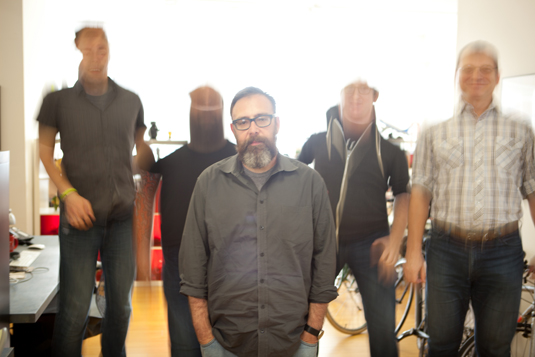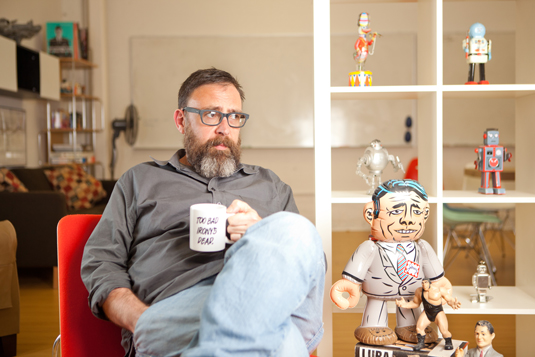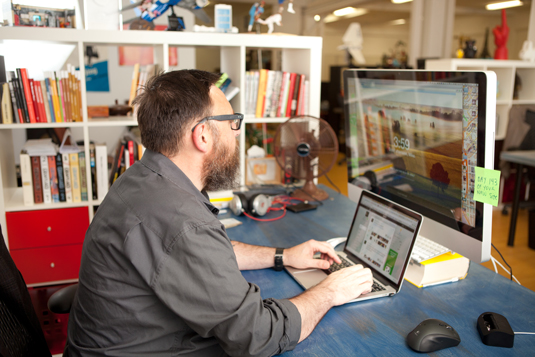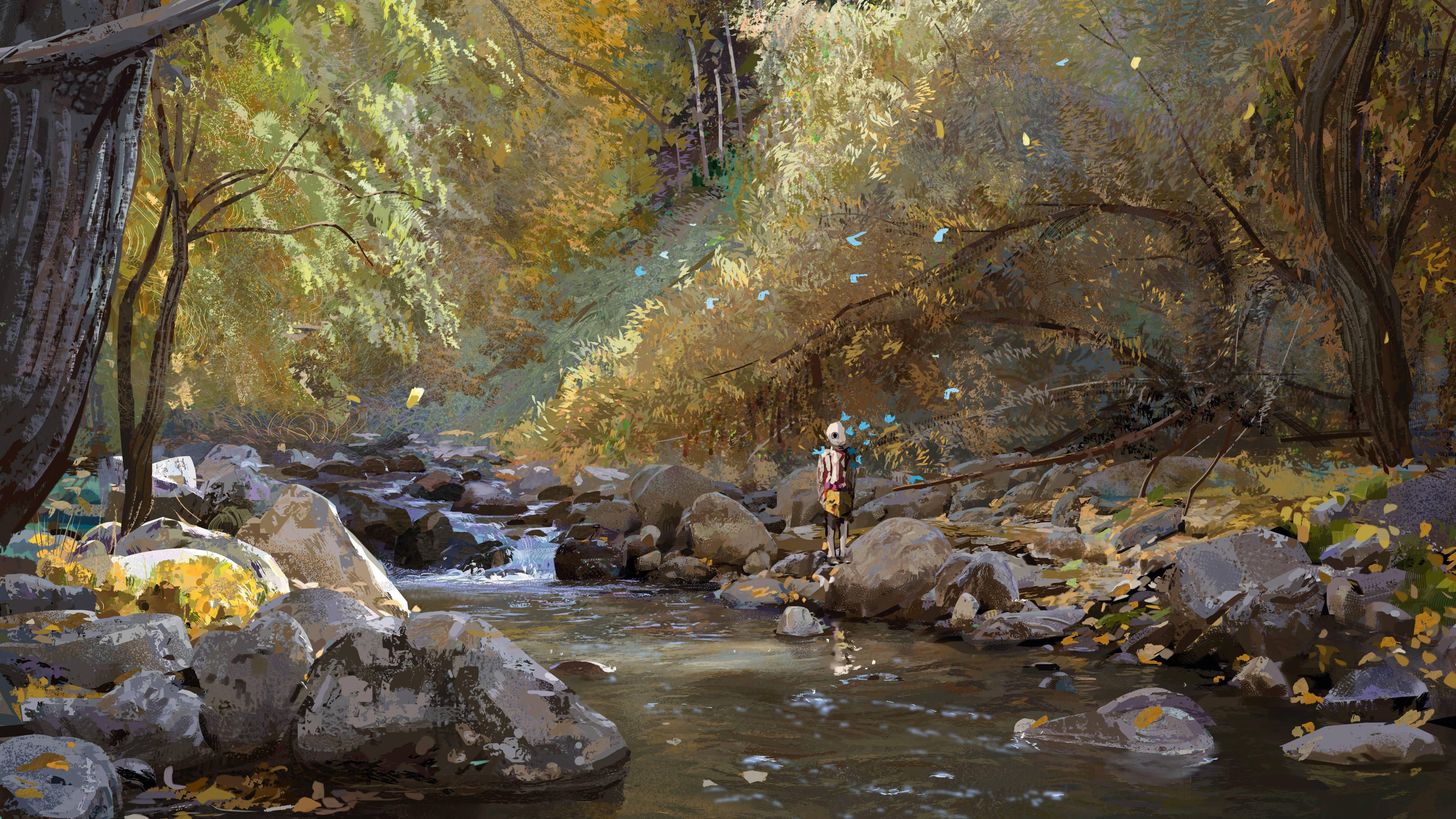Why designers need to stick to their guns
Truly great design happens when clients trust the experts and the experts stick to their guns, says Mule co-founder Mike Monteiro.

Mike Monteiro will be at Generate San Francsico on 15 July, where he'll be speaking in praise of ordinary people. Book now and become a founder member, with 50% off for all future Generates worldwide.
"'Fuck'? I say it to get people's attention," announces Mike Monteiro. "There's method to this madness. Web conferences are the most boring events in the world. We're all sitting there, checking our email and looking at Twitter, and there's this poor schmuck on stage. They're probably scared shitless... That's great, because nobody is paying attention."
Standing on stage and feeling the audience's enveloping ambivalence, Monteiro one day let the f-bomb slip. The audience stopped typing and looked up. He was clearly on to something.
When he's not delivering expletive-ridden polemics such as 'Fuck You. Pay me' at conferences, Monteiro also pens design books – including Design is a Job and, out soon, You're My Favorite Client. Day-to-day he runs the curiously titled Mule Design Studio, which he launched with Erika Hall in 2001.

So how did it all begin? "Accidentally," Monteiro says. "I was one of those misguided humans that went to art school to get a worthless art degree. I was also stupid enough to get a master's degree in Fine Arts. While I was doing that, I came across a part of the art building filled with Macintoshes."
"I started playing with the Macintoshes and found them great fun," he continues. "That's how I stepped into design. I graduated with a minor in Design and that's how I've earned my living since."
The web came into Monteiro's life some time later, mainly because it hadn't broken the surface yet. "First there was AOL, but that was a walled garden. Then, one day I logged on and there was this icon that said World Wide Web. I went kind of crazy. Anybody could do anything they wanted to do [on the web], as long as they could figure out how.
"So, I started figuring out how. It was like discovering punk rock. There was this whole ethos of 'we're not sure how to do this, but let's do it anyway … and we'll figure out what's good later'. There was no middleman and you didn't need anybody's permission. You made it and it existed and that was fantastic. I thought: 'This is for me!'"
Fantastic accidents
From that spark, Monteiro sums up his career path as a series of fantastic accidents, mistakes and misguided assumptions. "I applied for a job and basically lied through the interview and got the job. I then went home and figured out how to do [the job] before I started."
From there he started climbing the design studio career ladder. "Then, one day, I found myself thinking: 'I can run a design studio better than this', which was the dumbest thought that's ever entered my head. Fifteen years later, I have more empathy for the person that was running that studio than I've had for anyone in my entire life. I understand the pressure that person was under. I was also dumb enough to think that I could avoid bureaucracy. Nothing has ever been further from the truth."

Four-legged friends
So, having decided to set up his own shop, Monteiro needed the right name. "Did you know you can take mule rides to the bottom of the Grand Canyon?" he begins. "They put you on a mule and take you down a little trail. The first time they tried it, they used horses. Horses are beautiful, but also stupid and they jumped ... It was a terrible day. They eventually realised that they could use mules because mules won't do anything to harm themselves or their rider."
Mules, Monteiro explains, have a reputation for being stubborn because they measure every step very carefully before finally deciding to take it, and if the step looks risky, they'll stop. "So, if you're a rider and you trust your mule, you're safe. If you don't trust your mule you'll die. I thought, you know, that's a pretty good name for a design company. Today, we pride ourselves on taking care of our clients."
If you're a rider and you trust your mule, you're safe
Monteiro is, however, quick to point out that taking care of a client isn't the same as giving the client what they want. In his experience, clients often arrive in his office with a goal in mind, and then spend the rest of the project somehow trying to avoid the goal. For that reason, he says, he's happy to argue with clients and even refuse to design something he knows will only work a sticking-plaster.
"I want to design something that is right and something that will last," he says. This begs the question, how exactly do you define design and the role of the designer? Quick-fire, he replies: "Design is the solution to a problem with a set of constraints, and a designer is somebody who solves problems, given a set of constraints. That sounds so boring, but that's the job!"
Speaking up

Our conversation moves to discussing how bad design makes it into the world. Monteiro is unequivocal: fear is the father of bad design. He explains that, in his experience, people's reluctance to speak up leads to bad decisions, which in turn becomes bad products.
"Designers need to remember they are the experts," he explains. "If I need something designed and I don't have any expertise, I hire a designer. I tell the designer what I need to happen and they figure out how to make it happen."
The issue, Monteiro explains, is that designers don't present themselves as the expert and clients don't treat them as such. Rather, designers view themselves as a pair of hands that are willing to do whatever the client wants. "In essence, they're asking the client to be the designer, and to make the design decisions," he says. "
"The problem is, the reason the client decided to hire you is because they've decided they don't have any design expertise. Imagine you go to the doctor, and the doctor asks you how you want to be operated on or what kind of medicine you'd like."
Continuing his medical analogy, Monteiro explains that a doctor will go through a process of discovery, asking the patient about their problems. With that information, the doctor will use their knowledge and experience to diagnose the problem, and prescribe a cure. Monteiro says he's trying to get designers to act more like doctors as opposed to butlers, who simply do as they're told.
Selling yourself
Putting all your trust in a designer means it's especially important to ensure you've hired a good one. There is much attention paid to the role of the portfolio in the design world, and it's something Monteiro has to deal with himself when recruiting for Mule.
"You don't interrogate a portfolio," Monteiro says. "A portfolio gets you through the door. You should never hire anybody based on their portfolio. It's the same when I'm hiring a designer to work here. All the portfolio shows me is history. From there I get a gut reaction and I talk to the designer."
Rather than being seduced by the cleverness, beauty and the presentation of work, Monteiro is much more interested in the constraints foisted on the designer. "Looking at a portfolio shows me that design happened. I can see a good-looking thing but I don't know if the designer's solution [to the client's problem] worked.
"That's when I start reading the portfolio. I want to know what you were trying to solve, I want to know what constraints you were up against … budget, timeline, the number of client stakeholders in the room. I need to know all of that stuff and whether you went back in six months and checked if the initial project goals were met. Until I see all of this stuff, all I know is you can make pretty pictures."
Tell me your problems

So, how should a designer handle a client? How should they go about drawing out the goals and restrictions from their new paymaster? "I don't want to say it's like putting the client on the psychiatrist's chair, but it's very similar. I want designers to understand this [process of discovery] is part of their job.
"Making things on the screen is maybe 10 per cent of being a designer. I tell all my designers: 'Until you know exactly what it is you're trying to design, until you have an idea for a solution, until you're trying to test something out, do not sit down at your desk and start putting pixels and lines anywhere'."
The discovery process is difficult, and Monteiro warns against letting clients dump information on designers. It's great, he says, if a client has done lots of research before hiring a designer – but for him, it's more important to do the research himself. To, in effect, know exactly what the client knows, but first hand. Received wisdom is, sadly, second-rate wisdom.
Being a mercenary soul, I ask Monteiro how a client can ensure they're getting the best value for money from their designer. "You need to ask them as many questions as possible. Ask them why they're making the decisions they're making, ask them to tie those decisions back to goals and problems that they set up.
The sentence I hear most from clients is 'I don't know anything about design'. The way I respond is: 'Yes. But you know way more about your business than I ever will. Thankfully, you've hired somebody who knows a lot about design, so let's put the two together'."
I don't want to say it's like putting the client on the psychiatrist's chair, but it is very similar.
Finally we discuss how clients should give feedback to their designer. Here, again, Monteiro has some sharp opinions – based on bitter experience – about how to best demotivate your hired pixel-pusher.
"My favourite question is. 'Did you mean to use that typeface?' No, it just fell out of the bag. But it's easy to talk about the things clients do that make us bang our heads on the wall. The thing we need to remember is – as a craft – we're professionals who are trained to do this job and we do it every day."
Clients, by comparison, may never have been through a site redesign before and just don't know the process that needs to be followed. To a degree, Monteiro explains, the often complex world of client and designer relationships comes down to communication, patience and salesmanship.
"Look," he says. "It doesn't matter how good you are at making beautiful, usable, modern websites if you can't explain to a client why this is a good solution. All of that stuff is going into the trash if you can't sell it. A designer that knows how to sell mediocre work is more valuable to me than a designer that can't sell fantastic work."
Mike Monteiro will be closing Generate San Francisco with his keynote: In praise of ordinary people. Can't make it? There are upcoming Generate conferences in Sydney and London, too! This article originally appeared in net magazine issue 259. Subscribe today!

Thank you for reading 5 articles this month* Join now for unlimited access
Enjoy your first month for just £1 / $1 / €1
*Read 5 free articles per month without a subscription

Join now for unlimited access
Try first month for just £1 / $1 / €1
Get the Creative Bloq Newsletter
Daily design news, reviews, how-tos and more, as picked by the editors.

The Creative Bloq team is made up of a group of design fans, and has changed and evolved since Creative Bloq began back in 2012. The current website team consists of eight full-time members of staff: Editor Georgia Coggan, Deputy Editor Rosie Hilder, Ecommerce Editor Beren Neale, Senior News Editor Daniel Piper, Editor, Digital Art and 3D Ian Dean, Tech Reviews Editor Erlingur Einarsson, Ecommerce Writer Beth Nicholls and Staff Writer Natalie Fear, as well as a roster of freelancers from around the world. The ImagineFX magazine team also pitch in, ensuring that content from leading digital art publication ImagineFX is represented on Creative Bloq.
